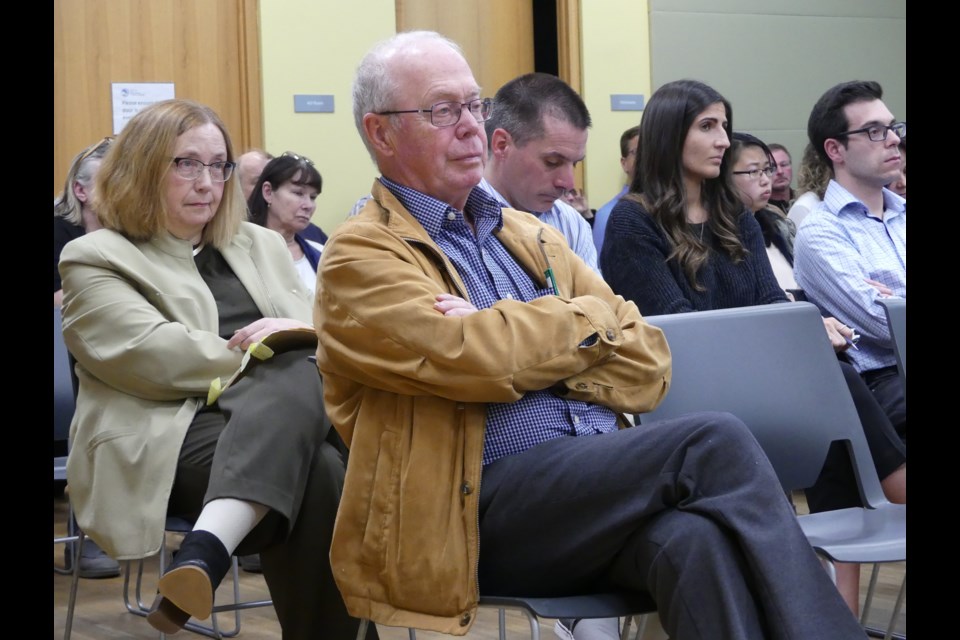Farmland, heritage properties, and traffic congestion were among the top concerns cited by Bradford West Gwillimbury residents at a public meeting about the town’s new official plan Monday.
About 60 people packed into the Zima Room at the Bradford West Gwillimbury Public Library for a review of the official plan and to share their questions and concerns.
Jody Mott, executive director for the Holland Marsh Growers Association, told town council she fears the new official plan, as is, will negatively affect local farmers.
“We are one of the main industries here. We are feeding 75 per cent of Ontario, 65 per cent in Canada, and we need to have this as a working document for the farmers. If not, we’re going to lose more farmland and more farmers, and I don’t know where the food’s going to come from,” she said.
Mott requested council meet with the association to work through their concerns.
“Some of the stuff that’s in it ties the farmer’s hands. Our understanding while working with the County of Simcoe (is that) some of the maps and overlays of some of the areas have been mapped incorrectly,” she said.
“A lot of times when the farmers apply to do things, right now they have to go through over 26 provincial approvals, 11 to 15 federal approvals, and then you’ve got your municipal and your county. So it’s a lot of work for them to provide safe, clean, nutritious food for everybody and we need to find a way to streamline that.”
Mayor Rob Keffer said he understood the crux of the issue that farmers do not want to be hindered.
“Once you have agricultural mapping, is a farmer able to build something new? I’d really like to see (agriculture) expanded a little bit in this document,” said Keffer, who is also a local farmer. “We don’t want to hamstring the agriculture community.”
Ward 3 Coun. Gary Lamb added the town needs to be prepared for the future needs of agricultural business: “Agricultural activity is going to change. Different types of processing is going to be the norm in the future. We need to be ready for that.”
Dr. David Chambers expressed his concerns to council about preserving heritage streetscapes in Bradford’s downtown by avoiding “high-density, insensitive infilling.”
“The town must have much more control over new building design in heritage sensitive areas,” he said. “Heritage must never be the sacrificial lamb in new development.”
As well, Chambers noted he would like to see the town protect historical farmhouses in the area from developers looking to build new housing or golf courses.
Several residents also brought concerns about the effect of the new official plan on their individual properties.
Walter Bak, speaking on behalf of his father, said the family’s farm on Bridge Street is already in a high-traffic area with vehicles headed toward Newmarket on nearby Dissette Street.
“The growth set out in this plan will compound this problem. If we achieve that growth, how is that going to affect our quality of life?” he said.
According to the new official plan, Bradford is expected to have a population of 50,500 people by 2031.
To meet this demand, the town expects to build 5,200 additional homes between 2016 to 2031 — or 350 per year.
In 2002, the Ontario Municipal Board approved an expansion of the Bradford Urban Area of about 1,100 hectares to accommodate growth until 2026, and the town’s official plan review a couple years ago confirmed its current supply of land would be enough for residential growth until 2031.
The Bradford GO Station, which is near Bak’s farm, is also referred to in the new official plan as a “significant asset” for local intensification.
“Anticipated future service and its location at the eastern edge of Downtown Bradford contribute to this facility as an important hub for all forms of transportation in the Town — as well as south Simcoe County and northwestern York Region,” it read.
Bak said constructing a Highway 400-404 connecting link could solve part of the traffic congestion problem from the expected growth.
Lamb said he was encouraged the provincial government is now considering a connecting link.
“Somebody’s got to come up with the billion dollars,” he said.
Town staff will now review the comments from Monday’s public meeting and report back to council at a later date.
The new official plan could be passed as early as May or June this year.



